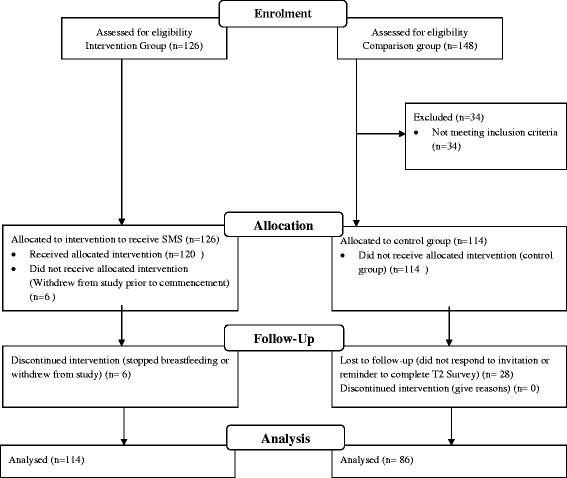Can a text message a week improve breastfeeding?
- PMID: 25369808
- PMCID: PMC4237760
- DOI: 10.1186/s12884-014-0374-2
Can a text message a week improve breastfeeding?
Abstract
Background: Breastfeeding is recognised as the optimal method for feeding infants with health gains made by reducing infectious diseases in infancy; and chronic diseases, including obesity, in childhood, adolescence and adulthood. Despite this, exclusivity and duration in developed countries remains resistant to improvement. The objectives of this research were to test if an automated mobile phone text messaging intervention, delivering one text message a week, could increase "any" breastfeeding rates and improve breastfeeding self-efficacy and coping.
Methods: Women were eligible to participate if they were: over eighteen years; had an infant less than three months old; were currently breastfeeding; no diagnosed mental illness; and used a mobile phone. Women in the intervention group received MumBubConnect, a text messaging service with automated responses delivered once a week for 8 weeks. Women in the comparison group received their usual care and were sampled two years after the intervention group. Data collection included online surveys at two time points, week zero and week nine, to measure breastfeeding exclusivity and duration, coping, emotions, accountability and self-efficacy. A range of statistical analyses were used to test for differences between groups. Hierarchical regression was used to investigate change in breastfeeding outcome, between groups, adjusting for co-variates.
Results: The intervention group had 120 participants at commencement and 114 at completion, the comparison group had 114 participants at commencement and 86 at completion. MumBubConnect had a positive impact on the primary outcome of breastfeeding behaviors with women receiving the intervention more likely to continue exclusive breastfeeding; with a 6% decrease in exclusive breastfeeding in the intervention group, compared to a 14% decrease in the comparison group (p < 0.001). This remained significant after controlling for infant age, mother's income, education and delivery type (p = 0.04). Women in the intervention group demonstrated active coping and were less likely to display emotions-focussed coping (p < .001). There was no discernible statistical effect on self-efficacy or accountability.
Conclusions: A fully automated text messaging services appears to improve exclusive breastfeeding duration. The service provides a well-accepted, personalised support service that empowers women to actively resolve breastfeeding issues.
Trial registration: Australian New Zealand Clinical Trials Registry: ACTRN12614001091695.
References
-
- World Health Organization . Report of the Expert Consultation on the Optimal Duration of Exclusive Breast Feeding. Geneva: WHO; 2001.
-
- World Health Organization . Global Strategy for Infant and Young Child Feeding. Geneva: WHO; 2003.
-
- Australian Health Ministers’ Conference: The Australian National Breastfeeding Strategy 2010-2015. Australian Government Department of Health and Ageing; 2009.
-
- Horta BL, Victora CG. Long Term Effects of Breastfeeding: A Systematic Review. Geneva: World Health Organization; 2013.
Publication types
MeSH terms
Associated data
LinkOut - more resources
Full Text Sources
Other Literature Sources
Medical


